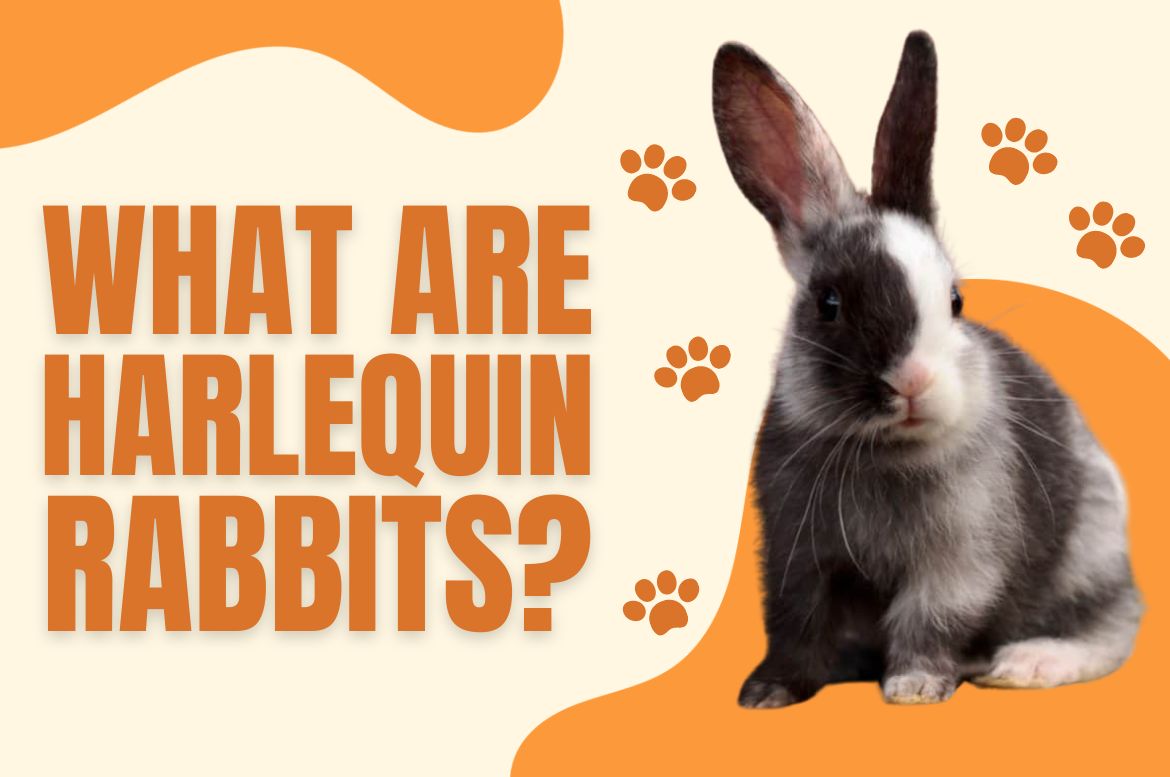
Harlequin rabbits are also called “clowns of rabbits” and “royal jesters” because their furry coats resembled clown costumes and court jesters in the past. This breed can be identified by its unique color pattern, unlike others that were bred for fur, meat, and bigger bodies. They are domestic bunnies that cannot survive in the wild.
Harlequin rabbits are muscular medium-sized bunnies with chubby and round bodies. They are bred for coat color and kept in indoor environment. Their body weight is 7 to 10 pounds on average. Moreover, their life expectancy is 13 years at maximum. The female does give birth to around 6 to 12 kits after 29 to 32 days of pregnancy. Their primary food source is hay, but they need other nutritive elements, too. They originated from Germany and are used as show rabbits.
Harlequin rabbits are playful animals and love to jump higher in the air. Despite their heavy weight, they can jump up to 3.5 feet, which seems pretty interesting. Additionally, they are one of the rarest breeds that are not commonly seen in houses.
Characteristics of Harlequin rabbits
| Characteristics | Harlequin Rabbits |
| Common names | Japanese rabbits, Clowns of rabbits |
| Physical appearance | Dual toned body with equal distribution of colors |
| Food choices | Hay and other fresh grasses |
| Body weight | 7 to 10 pounds |
| Litter size | 6 to 12 kits per litter |
| Common habitat | Domestic |
| Duration of Gestation | 29 to 32 days |
| Use | Show rabbits |
| Temperament | Intelligent and playful |
| Cost | $28 to $115 |
| Origin | Germany, France |
| Life expectancy | 6 to 10 years |
What makes a Harlequin rabbit?
Harlequin rabbits are produced for exhibition in shows, as their beautiful color attracts people. Tortoiseshell Danish rabbits, a Danish breed, are known for poorly colored furs.
This breed was bred with other common breeds to introduce a new breed with attractive fur color. The result of this breeding met expectations, and Harlequin rabbits were produced.
It was first exhibited in the 19th century in France. They became so popular and were imported to other countries globally after this exhibition.
Their number significantly increased in England and America because local people bought them to keep as pets. At that time, they were known as Japanese rabbits.
This name was adopted due to their country of origin, as they were first bred in Tokyo, Japan. Currently, this name is not in use, but a new name has been given to it according to appearance.
Furthermore, the fur color and pattern of Harlequin rabbits resembled clowns or court jesters. This is why their name got changed to Harlequin rabbits, which is popular nowadays.
What color are Harlequin rabbits?
The unique fur color and patterns make Harlequin rabbits different from other breeds. They are dual-toned bunnies where the two colors are equally distributed all over their body.
There are two different types of Harlequin rabbits based on the color pattern of their bodies. These types are Magpie and Japanese harlequin rabbits
Magpie harlequinsalso possess two colors where white color is present in combination with others like chocolate, blue, or black as secondary colors and contribute to formation of pattern.
However, Japanese harlequins also exhibit two different types of colors on their furry bodies. The primary color is orange, and other combination colors are black, chocolate brown, lilac, or blue.
Both types have medium-sized bodies that are muscular and round. Their coat furs are dense, short, and soft in texture. Based on the striking color feature, one of their ears is black, and the second one is orange.
They have erect ears, and eye color depends on the type. Some of their varieties have black, blue, and grey eye color, while a few have brown eyes.
Furthermore, half of their face is black, and the other half is golden orange. The same is the case with body color, as both sides of their body have different fur color. This way, a pattern is formed on their body naturally. Similarly, you can see color variation on their legs, too.
What do Harlequin rabbits eat?
Like other breeds, Harlequin rabbits require a balanced diet with good fiber content. Their digestive system is sensitive and gets disturbed if they do not get fiber-rich food.
Provide clean and fresh hay and leafy green vegetables to your pet harlequin rabbits, as they like to chew crunchy foods. They also like ripened fruits with high sugar content, but they should be offered in moderation.
Offer them fiber-rich foodstuff, but add essential vitamins and minerals in their diet. It helps prevent gastric issues in bunnies.
Pellets are also an important part of their diet if provided moderately. Avoid feeding them flavored, stored, or preserved foods, like juices, canned fruits, and jams. Fill their bowls with fresh water. Make sure to keep them hydrated.
In addition, the newborn kits do not feed on the grass, vegetables, and other hard-to-chew foods due to lack of advanced chewing skills. They are dependent on their mothers for food.
Similarly, the diet of young does and pregnant or lactating females is different because their body demands varying nutrition at different stages of their lifecycle.
Are Harlequin rabbits expensive?
The Harlequin rabbits are not common like other common breeds of bunnies. However, they are not expensive due to their low demand by people.
Their average cost ranges from $28 to $115, depending on their size and age. Also, this variation in cost depends upon their coat colors.
Their cost increases when they have more unique color patterns on their bodies. Other factors that determine the cost of bunnies are their weight, health condition, and gender.
Furthermore, you have to spend some extra dollars to meet their monthly expenses. The cost of food, cage, and maintenance is around $40 to $60, which is essential to spend for a better lifestyle and ideal growth.
How long do Harlequin rabbits remain pregnant?
Harlequin rabbits are known for their quick reproduction rate and short duration of pregnancy. The female remains pregnant for almost 29 to 32 days, but this could vary slightly.
After completing this gestation period, they give birth to 6 to 12 kits. On average, their litter size is 6 to 9 kits, but it increases to 12 in ideal situations.
The Harlequin rabbits produce more than 50 babies a year that can survive longer when they get proper care and nutrition. Out of 6 to 12 babies, some get a chance to complete their ideal lifespan of 6 to 10 years.
However, some of them die earlier if they get infected or physically injured. They cannot live more than a few days in the wild because they cannot live on their own.
What is Harlequin rabbit good for?
Before World War II, Harlequin rabbits were raised and used for meat production. Their muscular body is suitable for meat production as it is a few inches smaller than giant breeds.
They were first shown at an exhibition in the late 19th century in France. After that, they were mostly used for exhibition and became popular as show rabbits. Their color pattern or variety of combinations make them the best candidates for a rabbit show.
Furthermore, breeders are still making crosses with other beautiful breeds to get more beautiful combinations and patterns on their bodies. Therefore, you can expect to see more of their varieties in exhibitions and shows.
What is the size and weight of Harlequin rabbits?
Harlequin rabbits are medium in size and possess bulky bodies. You can identify male and female bunnies by their size and weight, as a significant difference is there.
They weigh around 6.2 to 8.5 pounds, which is equivalent to 2.8 to 3.85kg. In contrast, the female Harlequin rabbits weigh almost 8 to 10 pounds or 3.6 to 4.5kg.
Therefore, the male bucks are smaller and lighter than their female counterparts. Similarly, the female does can reach up to 13 pounds when they get an ideal diet and living conditions.
Additionally, their body length is similar to medium-sized bunnies and ranges between 9.3 inches to 11.6 inches. It could vary in different types of Harlequin rabbits but generally comes within this range.

